Air Algerie: A Study on Performance and Restructuring Plan
Added on 2023-06-09
56 Pages16442 Words95 Views
Chapter one : Background of Air Algerie
1.1 Objective of the study
The objective of this thesis is to identify the reasons of the relatively low performance of Air
Algerie compared to its competitors in terms of financial performance, market share, cost
control, fleet size, network and marketing strategy, and what are the determinant factors to
enhance its performance. And finally to suggest some changes as restructuring plan, to improve
its current position in the market share.
Our thesis will be basis initially from an internal analysis data, from the last three years of Air
Algerie’s Balance Sheet and Income Statement. Especially for the performance ratios
identification from: risks and solvency, international airlines comparison (financial ratios), sales
and lease back, Foreign Exchange (risk management), fuel price exposure (commodities risk),
fleet use optimization, network development, determinants of airlines cost (leasing) and the
strategy behind of the Government.
1
1.1 Objective of the study
The objective of this thesis is to identify the reasons of the relatively low performance of Air
Algerie compared to its competitors in terms of financial performance, market share, cost
control, fleet size, network and marketing strategy, and what are the determinant factors to
enhance its performance. And finally to suggest some changes as restructuring plan, to improve
its current position in the market share.
Our thesis will be basis initially from an internal analysis data, from the last three years of Air
Algerie’s Balance Sheet and Income Statement. Especially for the performance ratios
identification from: risks and solvency, international airlines comparison (financial ratios), sales
and lease back, Foreign Exchange (risk management), fuel price exposure (commodities risk),
fleet use optimization, network development, determinants of airlines cost (leasing) and the
strategy behind of the Government.
1
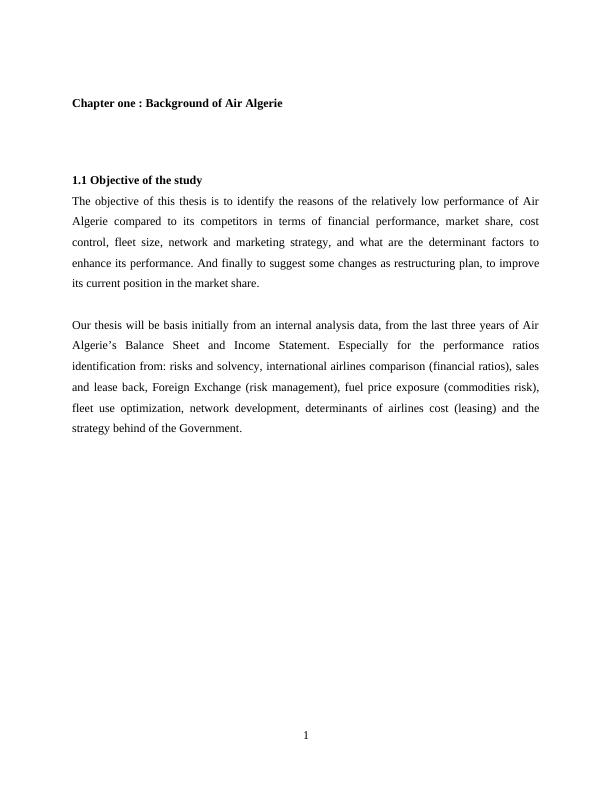
1.2 Method of analysis
After this initial and internal survey, we will identify the macro vision reasons of their low
performance compared to other two competitors: Royal Air Maroc and Royal Jordanian, are the
real competitors with same size.
According to the reasons and facts observed, will we verify the options to become a better place
as airline and changes against the research of other two airlines under restructuring plan
influenced by economic factors. Would be the case of: South African Airways and Kenya
Airways which both are in restructuring plans with some financial issues, aggravated by 2008’s
stock market crash and oil price collapse since 2015, respectively.
We will collect all the examples above mentioned and used them to support us to identify of new
restructuring plan to Air Algerie. Including also the challenge to find the passenger profile, what
they are envisioning, the destination, and the Air Algerie’s culture, for converting in one big
picture of the company in values and proposals.
In conclusion, after this research, we will finally be able to form our opinion of what would be
the next steps of internal changes and external ones, to place an Air Algerie in better position in
the market share.
2
After this initial and internal survey, we will identify the macro vision reasons of their low
performance compared to other two competitors: Royal Air Maroc and Royal Jordanian, are the
real competitors with same size.
According to the reasons and facts observed, will we verify the options to become a better place
as airline and changes against the research of other two airlines under restructuring plan
influenced by economic factors. Would be the case of: South African Airways and Kenya
Airways which both are in restructuring plans with some financial issues, aggravated by 2008’s
stock market crash and oil price collapse since 2015, respectively.
We will collect all the examples above mentioned and used them to support us to identify of new
restructuring plan to Air Algerie. Including also the challenge to find the passenger profile, what
they are envisioning, the destination, and the Air Algerie’s culture, for converting in one big
picture of the company in values and proposals.
In conclusion, after this research, we will finally be able to form our opinion of what would be
the next steps of internal changes and external ones, to place an Air Algerie in better position in
the market share.
2
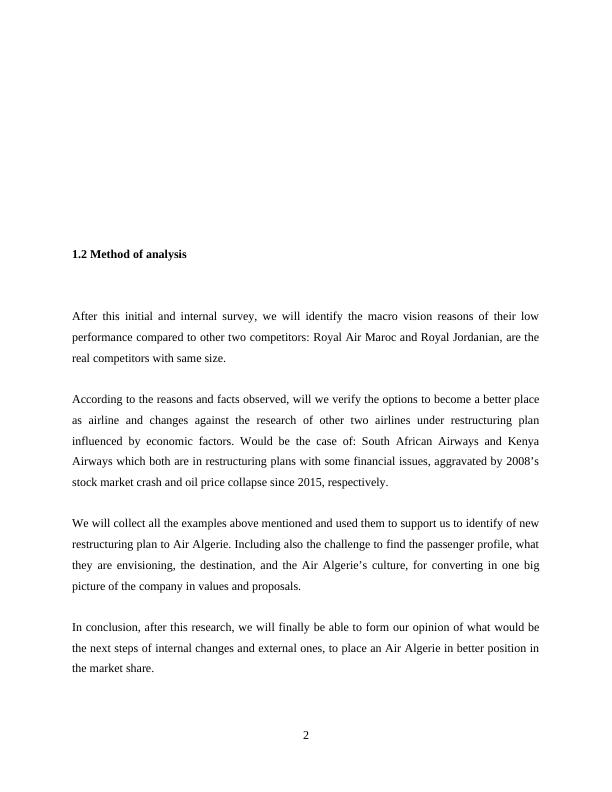
In this analysis, both primary and secondary data will be collected from Air Algerie’s data from
websites and air journal. Analysis of the Profit & Losses from 2016, 2017 Balance sheet.
Questionnaire and interview will be used to collect the primary and secondary data.
1-Internal Data
2-Direct Observation, based on competitors an another restructuring plans.
3-Consulting
1.3 The Airline industry history and Africa and Algeria's Air transportation
Aviation began early in the 20th century entered the modern age after WWII. Began a trend
toward deregulation in 1978. Became a mass market product that spread internationally ever
since. Airlines are a tool for economic development, it is a 500+b industry that’s essential to the
modern-day economic system.
The airlines must follow the safety regulations (EASA, FAA, ICAO, IATA,...) and
environmental regulations, airport restrictions.
In the Airlines there are many different stakeholders as: passengers, workers, airports, financiers,
suppliers, governments, air navigation providers, marketing partners, etc.
The main airline industry’s characteristics are:
Commercial systems
Booking and reservation systems
3
websites and air journal. Analysis of the Profit & Losses from 2016, 2017 Balance sheet.
Questionnaire and interview will be used to collect the primary and secondary data.
1-Internal Data
2-Direct Observation, based on competitors an another restructuring plans.
3-Consulting
1.3 The Airline industry history and Africa and Algeria's Air transportation
Aviation began early in the 20th century entered the modern age after WWII. Began a trend
toward deregulation in 1978. Became a mass market product that spread internationally ever
since. Airlines are a tool for economic development, it is a 500+b industry that’s essential to the
modern-day economic system.
The airlines must follow the safety regulations (EASA, FAA, ICAO, IATA,...) and
environmental regulations, airport restrictions.
In the Airlines there are many different stakeholders as: passengers, workers, airports, financiers,
suppliers, governments, air navigation providers, marketing partners, etc.
The main airline industry’s characteristics are:
Commercial systems
Booking and reservation systems
3

Revenue and pricing management
Customer management
Social media
Scheduling systems
It is a business where losses are more common than profits. Where the vast majority of start-ups
fail. Everyone who fantasizes about starting an airline knows the risks. Yet there are always
entrepreneurs eager to send them aloft and investors willing to gamble on the venture. They are
driven by the very human aspiration to succeed where others have failed
The systems to management, planning and control:
Flight Operations systems:
Crew planning and scheduling
Flight planning; OCC: (flight tracking; hub control; weather)
Airport systems:
Departure control (check-in, load sheet, weight and balance)
Airport flight information and customer systems
Maintenance planning and control
Financial systems and accounting
In this market, which is an equipment very expensive, most of employees are unionized and the
inventory is spoiled every time a flight takes off with unsold seats, the bottom line is very
vulnerable to GDP growth and the price of fuel.
With relatively minimal profit margins, the financial condition of the airline industry is highly
dependent on the global economic conditions. During times of economic boom, profits soar and
in times of recession airlines are forced to reduce capacity. Prior 1978, the industry was
relatively stable based mainly on the government's enforcement of non-competitive regulation
4
Customer management
Social media
Scheduling systems
It is a business where losses are more common than profits. Where the vast majority of start-ups
fail. Everyone who fantasizes about starting an airline knows the risks. Yet there are always
entrepreneurs eager to send them aloft and investors willing to gamble on the venture. They are
driven by the very human aspiration to succeed where others have failed
The systems to management, planning and control:
Flight Operations systems:
Crew planning and scheduling
Flight planning; OCC: (flight tracking; hub control; weather)
Airport systems:
Departure control (check-in, load sheet, weight and balance)
Airport flight information and customer systems
Maintenance planning and control
Financial systems and accounting
In this market, which is an equipment very expensive, most of employees are unionized and the
inventory is spoiled every time a flight takes off with unsold seats, the bottom line is very
vulnerable to GDP growth and the price of fuel.
With relatively minimal profit margins, the financial condition of the airline industry is highly
dependent on the global economic conditions. During times of economic boom, profits soar and
in times of recession airlines are forced to reduce capacity. Prior 1978, the industry was
relatively stable based mainly on the government's enforcement of non-competitive regulation
4
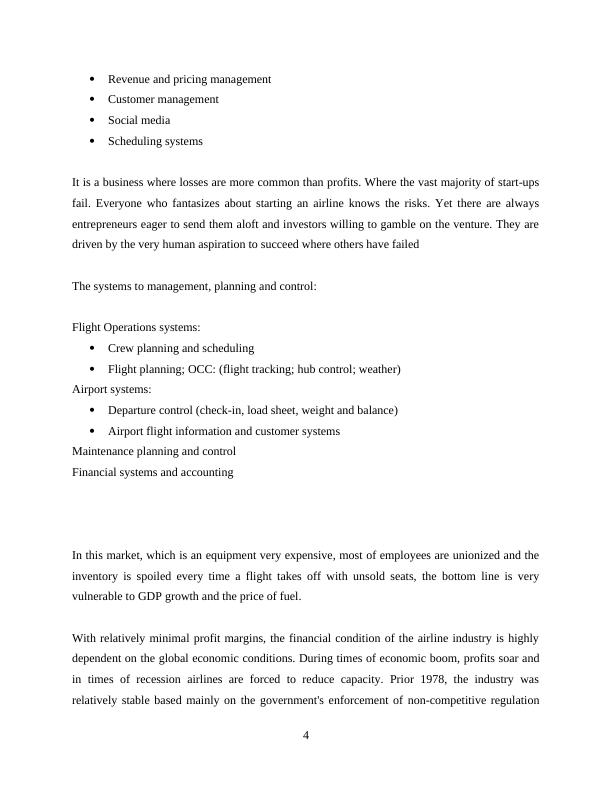
and pricing. In the post-deregulation era, the industry took on the more cyclical nature of a
competitive industry, where periods of financial results could followed by a turbulent economic
period. The financial condition of the air transport industry is relevant to the economic growth,
so it is therefore not surprising that the airline industry suffered when the economy stalled.
Before deregulation, domestic traffic was organized according to the rule established by each
country, for each country the local authority was responsible to determine which carriers could
fly what routes, specified what capacity each approved carrier could offer on each route and what
fares were to be charged.
In the United States the Civil Aeronautics Act of 1938 was introduced to regulate and control
competition between US domestics carriers, the lawless competition had led to anarchic
economics conditions, little security to investors and low safety margins.
Three arguments were used to justify the implementation the Civil Aeronautics Act of 1938, the
first one was, the absence of any regulation of market entry, would lead to a destructive
competition. The fact that the industry has non differentiated product and relative low barriers
for new entrants, the small new entrant airlines would not have a cost disadvantage when
competing against much larger incumbents, those new entrants into particular market would try
to establish themselves by under-cutting existing fares, causing price war with dramatic
consequences for the air transportation industry.
The second argument favoring regulation was that air transport is a public utility, arising
economic, social and political benefits, and regulation is more than needed in order to ensure that
the benefits were not endanger, the public utility of air transport was considered so important that
most countries except the United States launched their flag carriers with direct government
participation. "The same carrier often operated domestic services and acted as the designated
foreign carrier , it was a natural extension of this point of view to believe that free and
unregulated competition on international air routes would endanger national interests because it
might adversely affect that national state owned airlines" (Doganis 2010).
5
competitive industry, where periods of financial results could followed by a turbulent economic
period. The financial condition of the air transport industry is relevant to the economic growth,
so it is therefore not surprising that the airline industry suffered when the economy stalled.
Before deregulation, domestic traffic was organized according to the rule established by each
country, for each country the local authority was responsible to determine which carriers could
fly what routes, specified what capacity each approved carrier could offer on each route and what
fares were to be charged.
In the United States the Civil Aeronautics Act of 1938 was introduced to regulate and control
competition between US domestics carriers, the lawless competition had led to anarchic
economics conditions, little security to investors and low safety margins.
Three arguments were used to justify the implementation the Civil Aeronautics Act of 1938, the
first one was, the absence of any regulation of market entry, would lead to a destructive
competition. The fact that the industry has non differentiated product and relative low barriers
for new entrants, the small new entrant airlines would not have a cost disadvantage when
competing against much larger incumbents, those new entrants into particular market would try
to establish themselves by under-cutting existing fares, causing price war with dramatic
consequences for the air transportation industry.
The second argument favoring regulation was that air transport is a public utility, arising
economic, social and political benefits, and regulation is more than needed in order to ensure that
the benefits were not endanger, the public utility of air transport was considered so important that
most countries except the United States launched their flag carriers with direct government
participation. "The same carrier often operated domestic services and acted as the designated
foreign carrier , it was a natural extension of this point of view to believe that free and
unregulated competition on international air routes would endanger national interests because it
might adversely affect that national state owned airlines" (Doganis 2010).
5

The third argument supporting regulation of international air transport, rapid development of
charter flights, it was argued that scheduled traffic was relatively thin, for even a small loss of
traffic might jeopardize the continuation of scheduled operations.
During the 1960s economist began to question the benefits of regulation and argued the
advantages of deregulation and free competition, explaining that the existing regulation limited
pricing freedom, restricted capacity growth and excluded new entrants. If deregulation was
implemented, a more competitive environment would provide more benefits to the consumers in
terms of fares, and some inefficient airlines would be forced to leave some market or even the
industry, lower fares would force the airlines to review their costs and to improve their efficiency
and productivity.
Economist explained that the airline industry was not different from the other industrial and
service sectors, so neither the airlines nor the consumers needed special protection, and the anti-
monopoly regulation is sufficient to protect the consumer interest, if due to bad management the
incumbents airlines went bankrupt, others would position in the market.
In 1978, the newly elected president Carter, who made support for consumers a key part of his
election platform, signed the Airline Deregulation Act into law on 24 October. This set off a
chain of events which over the next 30 years were to transform international air transport from a
protected and highly regulated industry into one which is more truly open and competitive
industry (Stephen Shaw 2010) .
The deregulation came to Europe more than 10 years later, before the deregulation introduction,
European air transport was dominated by state owned carriers or flag carriers. Protected by their
respective government, their networks were immune to competition some airlines had seldom
recorded a profit during their entire existence, relying fully on government subsidies.
In 1987, the European Commission introduced its three phases ten- years reform process. The
EU airlines were gradually granted rights to operate on any route in the EU, including flight
wholly within another country (Cabotage). In late 1992, the European Union (EU) had passed
6
charter flights, it was argued that scheduled traffic was relatively thin, for even a small loss of
traffic might jeopardize the continuation of scheduled operations.
During the 1960s economist began to question the benefits of regulation and argued the
advantages of deregulation and free competition, explaining that the existing regulation limited
pricing freedom, restricted capacity growth and excluded new entrants. If deregulation was
implemented, a more competitive environment would provide more benefits to the consumers in
terms of fares, and some inefficient airlines would be forced to leave some market or even the
industry, lower fares would force the airlines to review their costs and to improve their efficiency
and productivity.
Economist explained that the airline industry was not different from the other industrial and
service sectors, so neither the airlines nor the consumers needed special protection, and the anti-
monopoly regulation is sufficient to protect the consumer interest, if due to bad management the
incumbents airlines went bankrupt, others would position in the market.
In 1978, the newly elected president Carter, who made support for consumers a key part of his
election platform, signed the Airline Deregulation Act into law on 24 October. This set off a
chain of events which over the next 30 years were to transform international air transport from a
protected and highly regulated industry into one which is more truly open and competitive
industry (Stephen Shaw 2010) .
The deregulation came to Europe more than 10 years later, before the deregulation introduction,
European air transport was dominated by state owned carriers or flag carriers. Protected by their
respective government, their networks were immune to competition some airlines had seldom
recorded a profit during their entire existence, relying fully on government subsidies.
In 1987, the European Commission introduced its three phases ten- years reform process. The
EU airlines were gradually granted rights to operate on any route in the EU, including flight
wholly within another country (Cabotage). In late 1992, the European Union (EU) had passed
6

legislation deregulating the airline industry. By January 1993 the European airlines had free
access to all international routes in the EU and could set their own fares. The step following the
deregulation Act was the open skies agreement. In 1993 the US and the Netherland Government
negotiated an open sky agreement followed by a large number of agreement between the US and
others Governments. Allowing to each side designate the number of airlines, these airlines are
then free to fly to any city with no limitations on their capacity and pricing decision.
Following the increasing number of air services agreement between individual European
countries and foreign countries, the European Court published a judgment on 5 November 2002,
the Court considered that any individual member governments of the European Union offended
against EU competition law if they signed Air Services Agreements with other countries that
limited the use of traffic right purely to airlines were owned and controlled by their citizens.
Such rights should had potentially to be available to all EU airlines. If they were not, such
discrimination was an infringement of the competition articles in the Treaty of Rome. The
outcome of this judgment was a completely new system, the European Commission would take
over the negotiation of external aviation relationship with other countries on behalf of all EU
members’ states.
In less than 30 years, from 1992 to 2010, the airline industry had known an amazing change,
many of the airlines that dominated the industry during a long period of time, such as Panama,
TWA, Sabena or Swissair declared bankruptcy and ultimately ceased operation others like Delta
and Northwest and United and Continental survived bankruptcy but merged post-bankruptcy.
Low cost airlines had appeared as major players in the market, they began to make their mark
with lower prices and new routes, recording a high growth in North America, Europe and Asia,
however, the established airlines maintained control over their regional hubs. New entrant
carriers had only limited access to landing slots at major airports and the importance of
secondary airports started to grow.
7
access to all international routes in the EU and could set their own fares. The step following the
deregulation Act was the open skies agreement. In 1993 the US and the Netherland Government
negotiated an open sky agreement followed by a large number of agreement between the US and
others Governments. Allowing to each side designate the number of airlines, these airlines are
then free to fly to any city with no limitations on their capacity and pricing decision.
Following the increasing number of air services agreement between individual European
countries and foreign countries, the European Court published a judgment on 5 November 2002,
the Court considered that any individual member governments of the European Union offended
against EU competition law if they signed Air Services Agreements with other countries that
limited the use of traffic right purely to airlines were owned and controlled by their citizens.
Such rights should had potentially to be available to all EU airlines. If they were not, such
discrimination was an infringement of the competition articles in the Treaty of Rome. The
outcome of this judgment was a completely new system, the European Commission would take
over the negotiation of external aviation relationship with other countries on behalf of all EU
members’ states.
In less than 30 years, from 1992 to 2010, the airline industry had known an amazing change,
many of the airlines that dominated the industry during a long period of time, such as Panama,
TWA, Sabena or Swissair declared bankruptcy and ultimately ceased operation others like Delta
and Northwest and United and Continental survived bankruptcy but merged post-bankruptcy.
Low cost airlines had appeared as major players in the market, they began to make their mark
with lower prices and new routes, recording a high growth in North America, Europe and Asia,
however, the established airlines maintained control over their regional hubs. New entrant
carriers had only limited access to landing slots at major airports and the importance of
secondary airports started to grow.
7
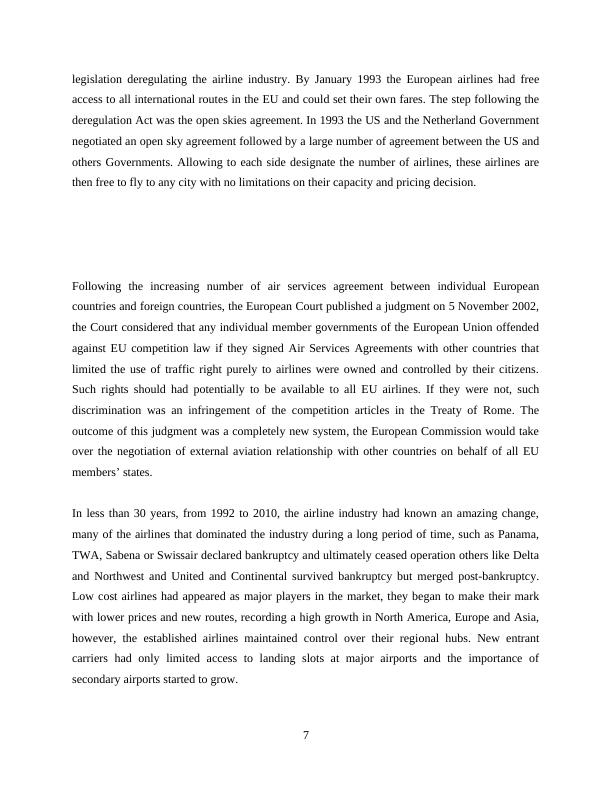
The most significant transformation in the airline industry after the deregulation remains the
airline alliances. It was estimated that in 2010, more than 95% of all airline passengers had
boarded a flight that was operated as part of an alliance. Airline alliances are known as the
innovative efforts which helps in providing suitable assistance to its customers and also tried to
improve the level of customer satisfaction.
The large number of members of global alliances can increase their negotiating power, when
dealing with suppliers, Iatrou and Oretti (2007) mention fuel, spare parts, maintenance, catering,
airports, charges or cabin crew training as potential sources of cost reduction they can also
reduce the cost of labor by sharing the sales office and bases, members can use cheap labor force
(pilots, flight attendants) of its allies from the other nation without reducing the service quality
and the same time reducing the cost (Iatrou 2004).
After African countries became independent, national governments established their own
airlines. Many newly independent countries desired to have their own flag carriers to showcase
their independence, and those countries wanted large jets like DC-10s and 747s even if the air
demand did not warrant those jets. Some airlines, like Air Afrique, were jointly sponsored by
multiple governments. Some joint carriers, such as Central African Airways, East African
Airways, and West African Airways, were established when the United Kingdom colonized parts
of Africa.
The knowledge of aircraft, the airline industry, and financial capital, originating from the
Europeans, was used to establish the new African carriers. Aircrafts in Africa tend to be older.
As of 2010, 4.3% of all aircraft in the world fly within Africa. Of older aircraft, 12% fly within
Africa. While older aircraft have low prices, they have higher fuel consumption rates and
maintenance costs than newer aircrafts.
Because many African airlines have low credit ratings, Africa has a low level of leasing
contracts. 5% of leased aircrafts in the world fly in Africa.
8
airline alliances. It was estimated that in 2010, more than 95% of all airline passengers had
boarded a flight that was operated as part of an alliance. Airline alliances are known as the
innovative efforts which helps in providing suitable assistance to its customers and also tried to
improve the level of customer satisfaction.
The large number of members of global alliances can increase their negotiating power, when
dealing with suppliers, Iatrou and Oretti (2007) mention fuel, spare parts, maintenance, catering,
airports, charges or cabin crew training as potential sources of cost reduction they can also
reduce the cost of labor by sharing the sales office and bases, members can use cheap labor force
(pilots, flight attendants) of its allies from the other nation without reducing the service quality
and the same time reducing the cost (Iatrou 2004).
After African countries became independent, national governments established their own
airlines. Many newly independent countries desired to have their own flag carriers to showcase
their independence, and those countries wanted large jets like DC-10s and 747s even if the air
demand did not warrant those jets. Some airlines, like Air Afrique, were jointly sponsored by
multiple governments. Some joint carriers, such as Central African Airways, East African
Airways, and West African Airways, were established when the United Kingdom colonized parts
of Africa.
The knowledge of aircraft, the airline industry, and financial capital, originating from the
Europeans, was used to establish the new African carriers. Aircrafts in Africa tend to be older.
As of 2010, 4.3% of all aircraft in the world fly within Africa. Of older aircraft, 12% fly within
Africa. While older aircraft have low prices, they have higher fuel consumption rates and
maintenance costs than newer aircrafts.
Because many African airlines have low credit ratings, Africa has a low level of leasing
contracts. 5% of leased aircrafts in the world fly in Africa.
8
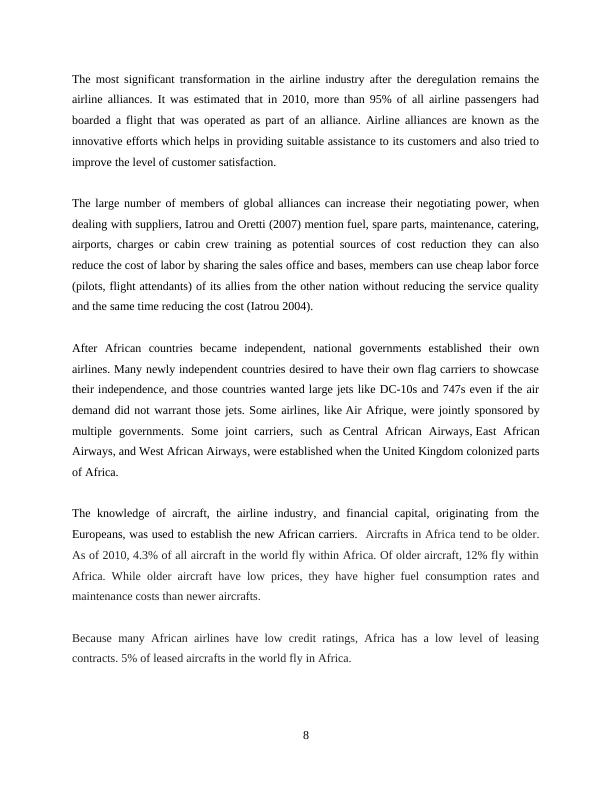
End of preview
Want to access all the pages? Upload your documents or become a member.
Related Documents
Air Algerie: A Study on Performance, Costs and Solutionslg...
|46
|11440
|413
( AFA)Advanced Financial Accounting Assignmentlg...
|19
|3447
|48
Financial Analysis Report: Accounting Information System, Revenue Recognition, Liability Analysislg...
|12
|4356
|58
Emirates Airline: A Case Study on External and Internal Factorslg...
|9
|2381
|199
Financial Analysis of Sydney Airport and Auckland Airport: Industry Overview, Stock Prices, and Ratioslg...
|26
|5114
|184
SWOT and PESTLE analysis of Ryanair and Leadership Styleslg...
|15
|3979
|313
